
Posted by
Mordy Oberstein
Well, it’s been quite the year for the SEO world. Watching events unfold day in and day out, you almost forget just how significantly things have changed for those of us within the SEO community. Sure, there have been the sort of blockbuster breakthroughs (think Penguin 4.0 or organic AMP results). Still, a lot of the changes we saw in 2016 were brought in slow increments, piece by piece (just compare Google’s Knowledge Panel as it is now to what it was a year ago). While there’s no way to cover all of the significant changes 2016 has brought, I’ll do my best to highlight the ones I think mattered most… and you might be surprised to see what made the list.
A Yearly Review of Google Updates and Tool Changes
It’s hard to know where to start when discussing an entire year of SEO and digital marketing changes, updates, etc. To quote the Big Lebowski, one finest movies ever made (at least in my opinion), “this a very complicated case… You know, a lotta ins and outs, lotta what-have-you’s.” Due to the diversity of the topics to be discussed when reviewing the year, I thought it would be appropriate to start with the industry’s top player, Google (where trillions of searches now happen every year).
2016’s Google Updates
Google themselves admits that there are thousands of algorithm updates that roll out each year. Even if I wanted to, I couldn’t address them all here, simply because Google does not announce the vast majority of its algorithm updates, and most fly well under the radar. Discussing just the major algorithms would be a task all unto itself, so for now I’ll lay out the year’s most significant updates. (For a full list of Google’s updates, both official and those relegated to “chatter” within the SEO community, please see our Google updates page which includes the “Algorithm *** Wire.”)
With that, let’s see what updates our Rank Risk Index picked up over the course of the year:
Google Core Quality Rank – January 9, 2016
As rank fluctuations went wild, it turns out that Panda became part of Google’s core ranking signals. As you’ll soon see, this was not the only major algorithm to go “core” in 2016.
Undisclosed Google Activity – May 10, 2016
While heightened rank fluctuations have a certain degree of normality to them simply because updates are so frequent, a prolonged series of high rank fluctuations is unusual. In early May we saw 7 continuous days of unusually high rank fluctuations. Though Google neither confirmed nor the denied an algorithm update had transpired, the industry overwhelmingly saw the rank activity as a Google update.
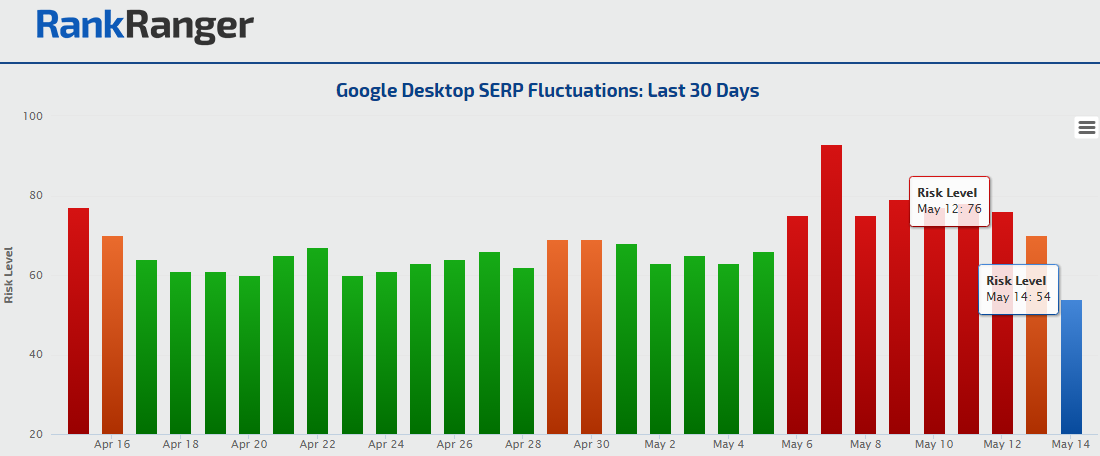
The Rank Risk Index shows high fluctuation levels between May 6th and 13th
Mobile Friendly Update – May 12, 2016
Fresh off the heels of Google’s “Undisclosed Activity” was an update that increased the significance of a page being mobile-friendly within Google’s ranking signals. This update was indeed confirmed by Google.
Possum Local Search Update – September 2, 2016
Named by the SEO community itself, and never confirmed by Google, the Possum update attempted to reduce the number of duplicate and spammy listings within Google’s Local Pack and Local Finder.
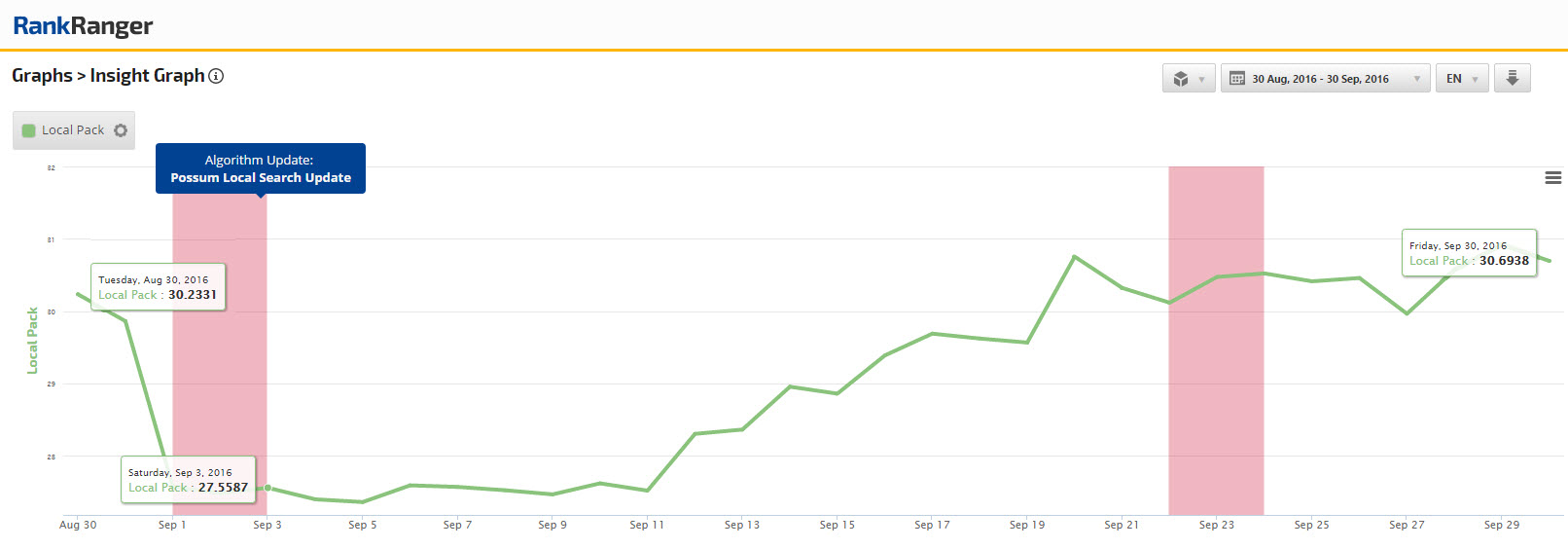
Local Pack on Page One of the SERP dips as the Possum algorithm rolls-out
Penguin 4.0 – September 23, 2016
The year ended where it began, with a major algorithm becoming part of Google’s “core.” Penguin 4.0 updates in real-time, which means you no longer need to wait for the release of the next version of the algorithm to be restored after a penalty (should you be unfortunate enough to be hit by the algorithm that is). This was one of the year’s most talked about stories within the SEO industry, if not the most talked about story.
Google Keyword Planner Restricts Data and Alters Results

I was really debating whether or not to lead off with this one only because the story was so huge and long lasting. Obviously, in this SEO recap I can’t rehash all of the gritty details, but in a nutshell Google made some changes to its Keyword Planner that did a good job shaking up the SEO community. With a timeline that stretched from the end of June through mid-August, Google rescinded Keyword Planner’s ability to show exact search volume data. In other words, instead of seeing exact search volume numbers, Google was showing ranges instead (i.e. 10K -100K). The obvious problem with these broad ranges is that you don’t know where within the range you fall. (Note, Google did leave access to specific data for accounts that met certain criteria).
Jump forward a month to mid-September and Google restricted Keyword Planner yet again. This time, Google’s change affected the actual keywords the tool showed you, as Keyword Planner began displaying variant terms. Essentially, Google changed things around so that Keyword Planner, more often than not, shows you results that are associated with your original query, but do not match it exactly. So for example, if you did search in Keyword Planner for home decoration, whereas before the change you would see data related to that specific term, now you see data related to the term home decor.
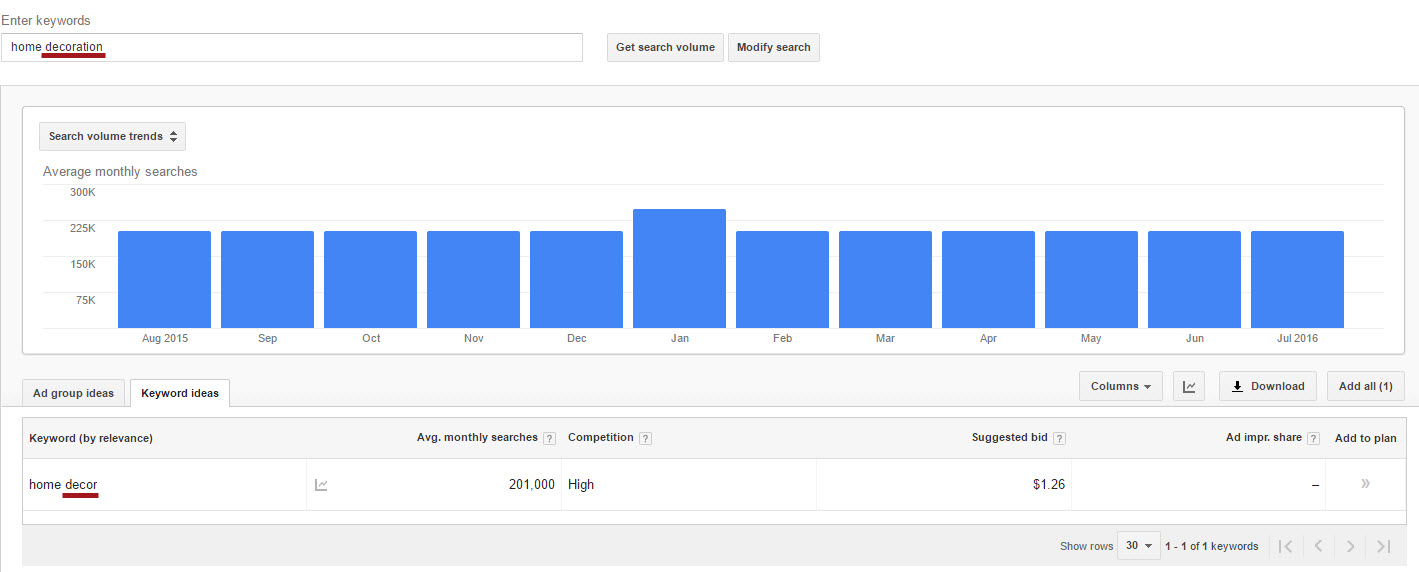
Keyword Planner shows a variant result when a query for “home decoration” is implemented
A Look Back at the Year in Mobile Search

If Google is the biggest “player” within the world of SEO, then the mobile web is a serious number two. So much attention has been given to this search medium that it almost seems like the mobile web dominated the news in the SEO world.
Mobile Usage in 2016
Dominate is a good word to use when you start looking at the numbers mobile posted in 2016. I could ramble on, or I could just share the data with you… I’ll do the latter:
Is it any surprise then that IAB said that mobile was responsible for roughly half all digital ad revenue though the first half of 2016?
AMP Enters the SERP
When thinking about the future of SEO, one story perhaps rises above the rest, that of AMP entering the SERP. AMP optimized pages first hit the mobile SERP within Google’s News Box SERP feature. Google, reaching out to major news publishers, began filling the News Box with AMP optimized articles. The shift towards news publishers going with the faster loading page format has not been without its controversy. An October 28th Wall Street Journal article brought forward the claim that many publishers are upset about earning significantly less money via their AMP pages when compared to their pages that are not AMP optimized.

The AMP icon appears within a news carousel
The AMP initiative took a big step forward when eCommerce giant, eBay, adopted the AMP format on mobile to increase page speed. This signified AMP breaking out of its until then “news publisher’s” box. Once out of the confines of news results, Google pushed AMP towards the next logical step of its evolution, organic results. On September 20th we began tracking AMP appearing within organic results on mobile globally. At the time of the writing of this article, roughly 15% of all Page One SERPs (United States) on mobile contain at least one organic AMP result.
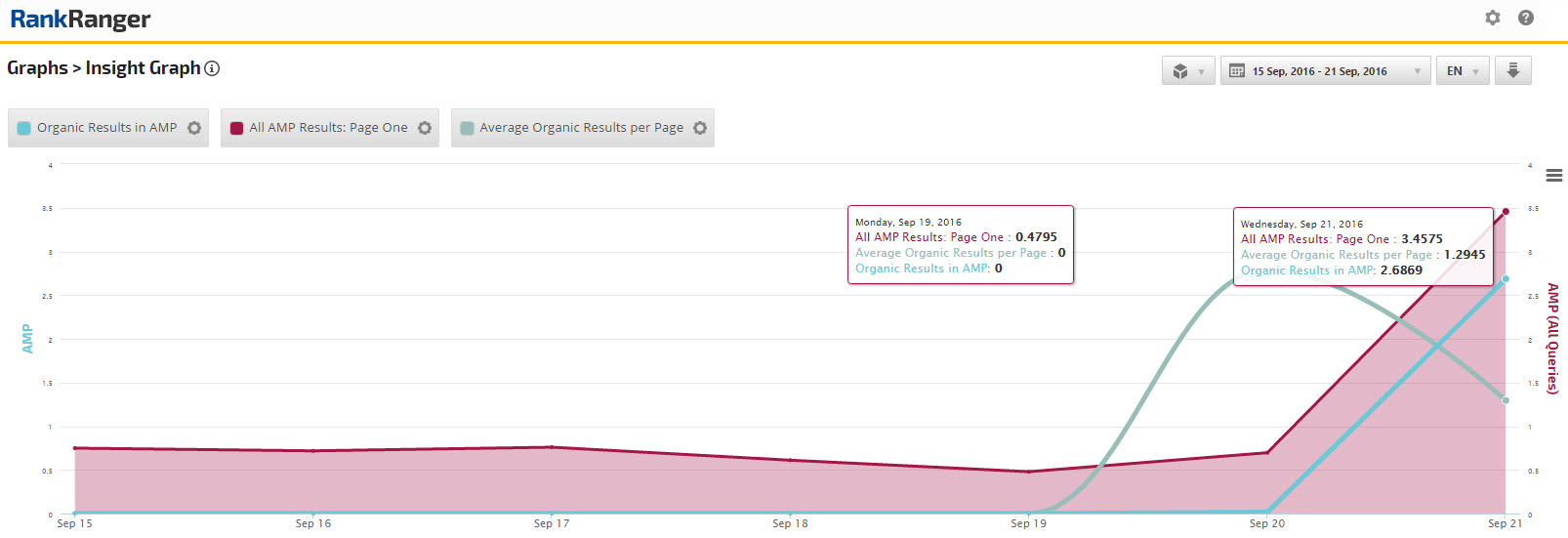
An Insight Graph showing AMP entering organic results
Google Announces the Mobile First Index
This ties into an earlier point, namely that majority of search queries are done on mobile. Because most search now happens on mobile, in early November Google started experimenting with a mobile first index. Until then Google had only a desktop index, though the idea of a separate mobile index had long been discussed. Doing away with the idea of a two indexes, a desktop index that functioned alongside a separate mobile index, Google went all in with the notion of a mobile first index (which it is currently testing).
Essentially, the mobile first index does what it sounds like. Google has now begun experimenting with making your mobile web pages the priority, thereby assigning rank based upon the mobile version of your pages, even on the desktop SERP. Traditionally, Google crawled the web and only indexed the desktop version of your site’s pages, assigning rank accordingly. Now, with the mobile first index, Google aims at crawling the web and indexing your mobile pages, and subsequently assigning rank accordingly. The practical difference being a scenario where your mobile site is different than your desktop site.
Changes to Google AdWords and Bing Ads in 2016
Changes to both Google AdWords and Bing ads were almost continuous as the year went on. Some changes reflected deep structural shifts, while others were more cosmetic. All in all, there were countless updates and changes made, here are some of the most notable ones from throughout 2016.
Sidebar Ads Removed from the Google SERP
Perhaps the biggest change in the digital advertising world this past year was Google’s removal of sidebar ads from the SERP. In February 2016 (which by now seems like ages ago) Google removed ads from the right side of the SERP, creating a white space power vacuum.
Expanded Text Ads
This was one of the biggest changes to ads of the year. Citing the removal of sidebar ads, Google increased the length of PPC ad titles and descriptions, capitalizing on the SERP’s right-sided white space. Within its July 26th announcement, Google said that as of October 26th, advertisers would no longer be able to either create or edit standard text ads. In September however, Google extended this deadline to January 31, 2017, giving advertisers more time to experiment with the new extended text format.
AdWords Cross Device Targeting
At the end of September 2016 Google gave advertisers the ability to target users across devices. Meaning, if a user clicked on your mobile ad you can now target the same user on desktop. As it stood previously, you simply couldn’t do so.
Google Announces Mobile Interstitial Ad Penalty
One of the biggest announcements of the year was when Google declared that come January 17th, 2017, sites hosting pages containing intrusive interstitial ads would be penalized. Google did release guidelines of sorts indicating what forms of interstitials are considered intrusive. This penalty could pose a significant threat to ad revenue.
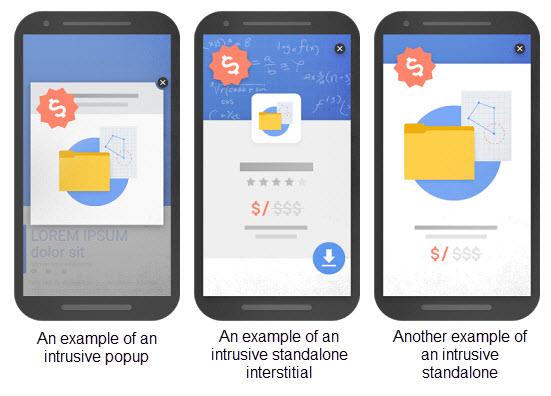
Google’s visual guide to what it considers to be intrusive interstitial ads on mobile
Google Bans Payday and High Interest Loan Ads
Along the lines of its interstitial ad announcement, Google actually banned two forms of ads it deemed to be of a borderline ethical nature in order to create a better user experience. The ban was supposed to go into effect July 13, 2016. However, it was not until October 10th that the ads seemed to disappear from the SERP for all intents and purposes.
Google Gives Ad Control to Users
Google is faced with creating a balance between having ads out there on the web, but not annoying users at the same time (as adblocking is only gaining momentum). Within this context, in late June 2016, Google began offering users the ability to see ads that reflect their interests. Not applicable to ads on the SERP per se, Google, within its “My Activity” portal, now presents users with various settings to help direct more relevant ads their way.
Home Service Ads Get the Google Guarantee
The background here is quite interesting. Briefly, Google was running a test on some advanced verification procedures for San Diego based plumbers and locksmiths in an effort to clean up Local Pack and Local Finder results from spam. What came out of the test were Home Service ads containing the “Google guarantee.”
Within the ad format, Google began attaching a green shield icon with the term Google guaranteed to certain vendors. The status indicates that the vendor is “licensed, insured, and pre-screened.” Since Google is offering its guarantee, it does put the search engine in a situation of some liability. As such, Google says that if the job is not done “right” you are entitled to your money back with Google saying, “If you are dissatisfied with work quality, we’ll cover claims up to the job invoice amount, with a lifetime cap of $2,000.”
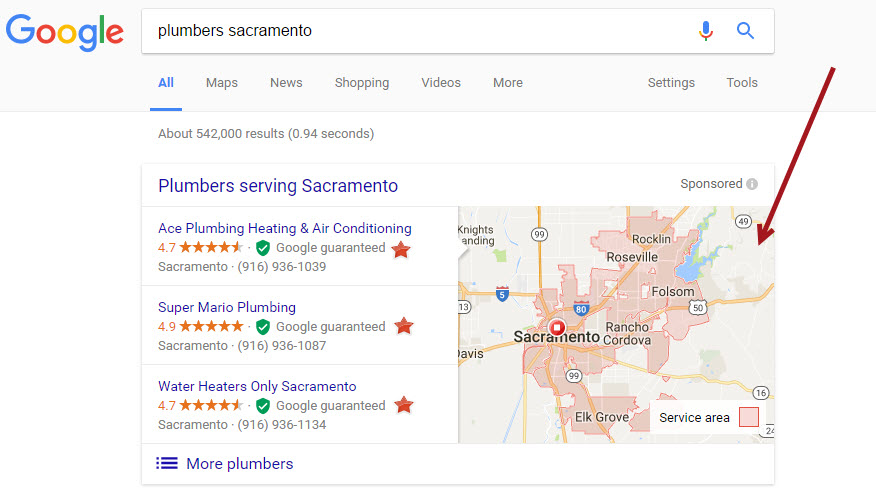
A Home Service ad pack shows with a map and vendors that have the Google guaranteed status
Adwords Ad Labels Get a More Organic Look
Though an aesthetic change, Google changing its PPC ad labels to green was significant nonetheless. If not because Google was testing new ad label colors for quite some time resulting in industry-wide curiosity and speculation, the color change gains its significance due to the choice of color ultimately implemented. Before the late June 2016 change, Adwords ad labels were traditionally bright yellow. After the change however, Google went with green, the same green it uses for its URLs within results. The effect were ads that looked a bit more organic in appearance, thus adding additional significance to the color choice and change.
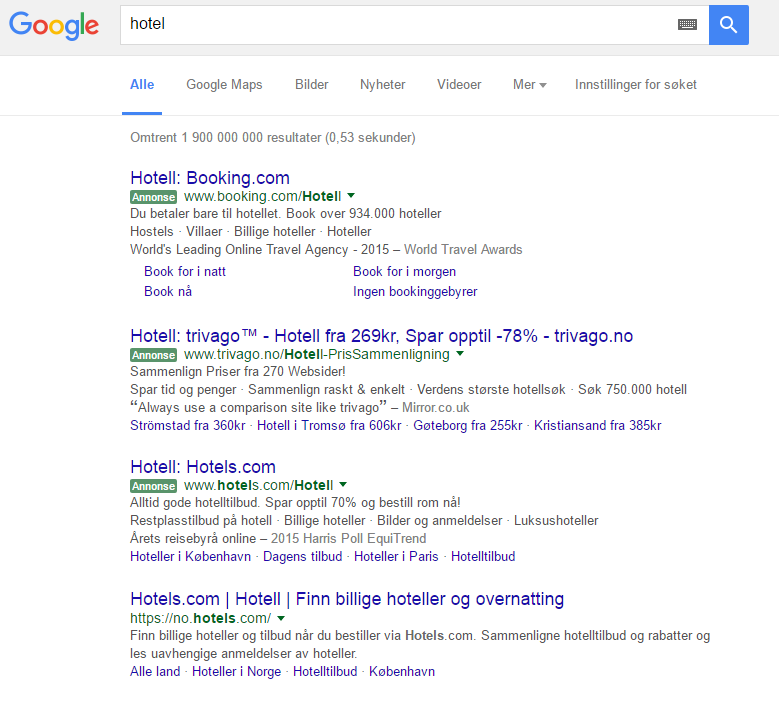
PPC ads from Norway show with green ad labels
A Series of Changes to Bing Ads
Google wasn’t the only one trying to improve the way it went about ads. 2016 saw Bing put in a concerted effort to improve its ad platform in hopes of increasing ad revenue. One of the ways Bing evolved was by improving the ways users could edit their ads. In June, Bing added the ability to edit text ads via a mobile device, and in September the search engine announced that users can use its mobile app to bulk edit ads, making it possible to pause multiple campaigns at once.
Also in September, Bing rolled out the ability to add Structured Snippets to text ads, followed by a pilot that enabled device bidding in October (which Google had also gone back to). Again in line with Google’s advertising strategy, Bing introduced Expanded Text Ads for all of its users towards the end of October 2016. Smartly, Bing allowed its users to import Expanded Text Ads from its rival, AdWords.
State of the Google SERP and SERP Features in 2016
The Google SERP and its SERP features underwent a lot of changes and an immeasurable number of tests during the 2016 year. Instead of going through every single test and change, which would just be impossible to do, I’ll focus on some of the major doings, as well as on some of the SERP features that are playing a bigger role in SEO as time goes on.
Changes to the SERP Layout
There were a quite a few changes and tests that impacted the very look of the SERP itself, most of them were minor and relatively insignificant. Be that as it may, there were two major changes to the layout of the SERP that made the cut:
1) Google increased the width of the search column (due to the space made available when sidebar ads were removed).
2) Google introduced a new UI that is more in line with its mobile SERP layout.
A Series of SERP Features Removed
Like those news sites bidding farewell to celebrities lost during the course of the year, we bade a heart-filled farewell to the following SERP features:
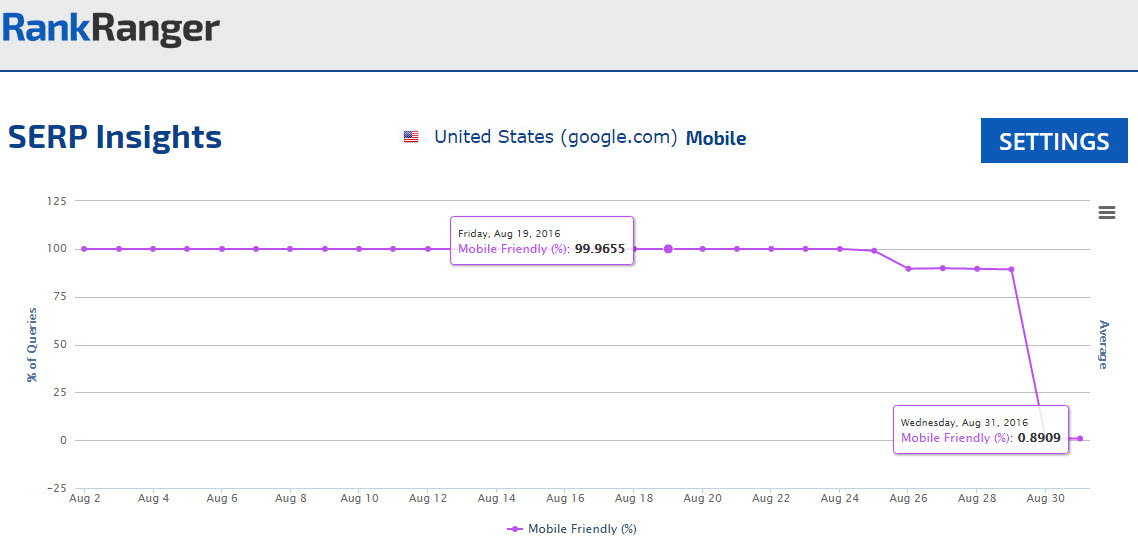
The Mobile SERP Feature Tracker shows the removal of the Mobile-friendly label
However, with the above SERP feature losses, 2016 saw the SERP gain some new features as well:
- Google Podium (aka Google Posts): Initially released to US presidential candidates, the feature, which displays a site’s content directly to the SERP, moved into standard search results. Google plans on expanding the feature to local businesses as well.
- Rich Cards: In mid-May Google released this mobile specific feature that functions as a carousel, providing content such as images, reviews, etc.
- Earthquake Feature: At the end of June, Google released a feature to help people who were either in, or near, an earthquake gain information about the quake.
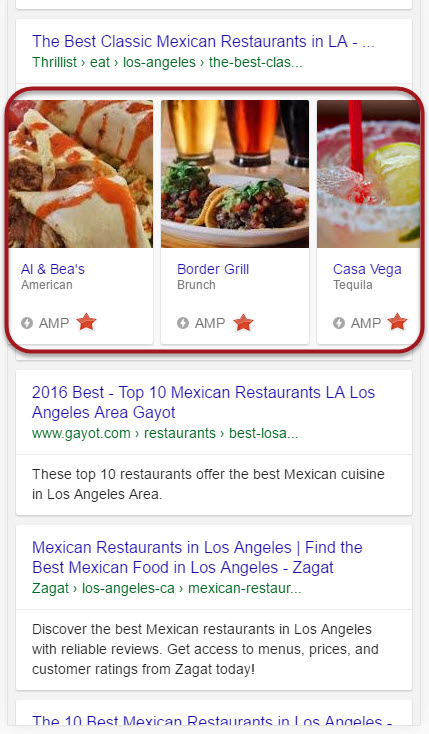
A Rich Card carousel shows with AMP results
Featured Snippets Expand in 2016
Featured Snippets were one of the hottest SERP features last year. A lot of this has to do with Google utilizing Feature Snippets to deliver answers to voice search queries. When available, Google Home will make use of a Featured Snippet, reading it word for word in order to deliver its response. This obviously would make the SERP feature popular at any SEO party. Perhaps this explains why the feature went from showing on just 2.5% of Page One SERPs as of January 1, 2016, to breaking past 10% towards the end of December (data represents desktop results in the US).
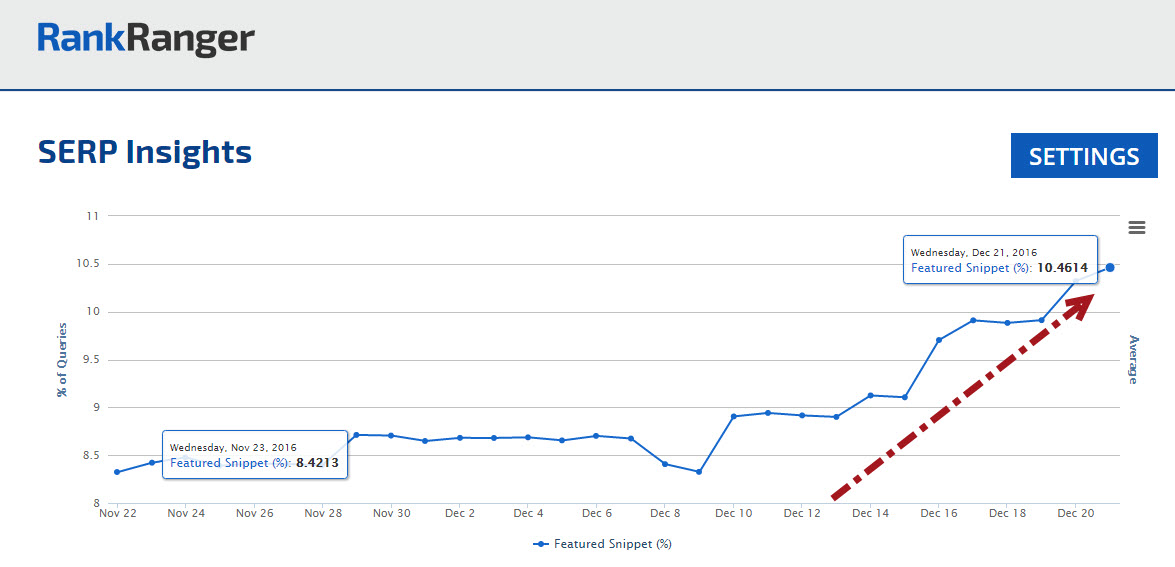
The SERP Features Tool shows Featured Snippets rising past the 10% mark on Page One of the US desktop SERP
Beyond its impressive gains on the desktop SERP in the US, 2016 saw Featured Snippets expand in Europe and in Spanish speaking countries.
2016 – A Year for Google’s Knowledge Panel
Nothing is more fitting with which to end our review of 2016 than Google’s Knowledge Panel. No other SERP feature has undergone so many changes that touch upon so many deep-seated SEO issues than Knowledge Panel.
Among other tests and additions, in 2016 we saw the Knowledge Panel gain:
- Critic reviews: The inclusion of professional reviews (i.e. Zagat).
- Reviews from the web: Following the inclusion of its critic reviews, Google inserted reviews from third party sites such as Facebook and Trip Advisor.
- Search items at this store: For participating retailers, Google includes a link to a Google page that shows the current in-store inventory.
- People typically spend: A estimation of how much time people typically spend at a given store.
- Live popular times: Added in November, the Knowledge Panel now tells you how heavy foot traffic is at certain stores in real-time.
- Videos from the web: Videos related to the content shown in the Knowledge Panel now appear when applicable.
- Google user TV/movie reviews: Google has added the ability to rate TV shows or movies from within the Knowledge Panel and has added a “Google users” rating.
- On TV soon: Via the knowledge panel users can see when the next episode of TV series is set to air.
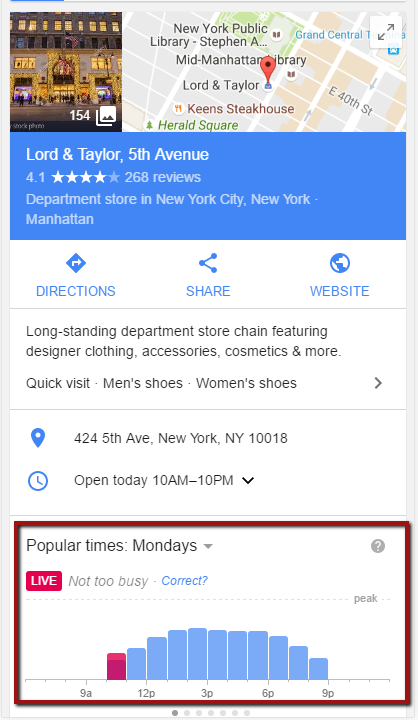
Real-time “popular times” on a Google Knowledge Panel
Knowledge Panel wasn’t without its controversy however. When Google ran its “Olympics feature” (which was essentially a mobile-like Knowledge Panel operating on desktop) to help users track the Games in Rio, questions arose as to whether the Knowledge Panel did too good of a job. Due to the deep scope of this deep Knowledge Panel (which is standard on mobile) there was some concern that it made related websites obsolete. (Why go to the ranking websites when you can get what you need right in the Knowledge Panel?)
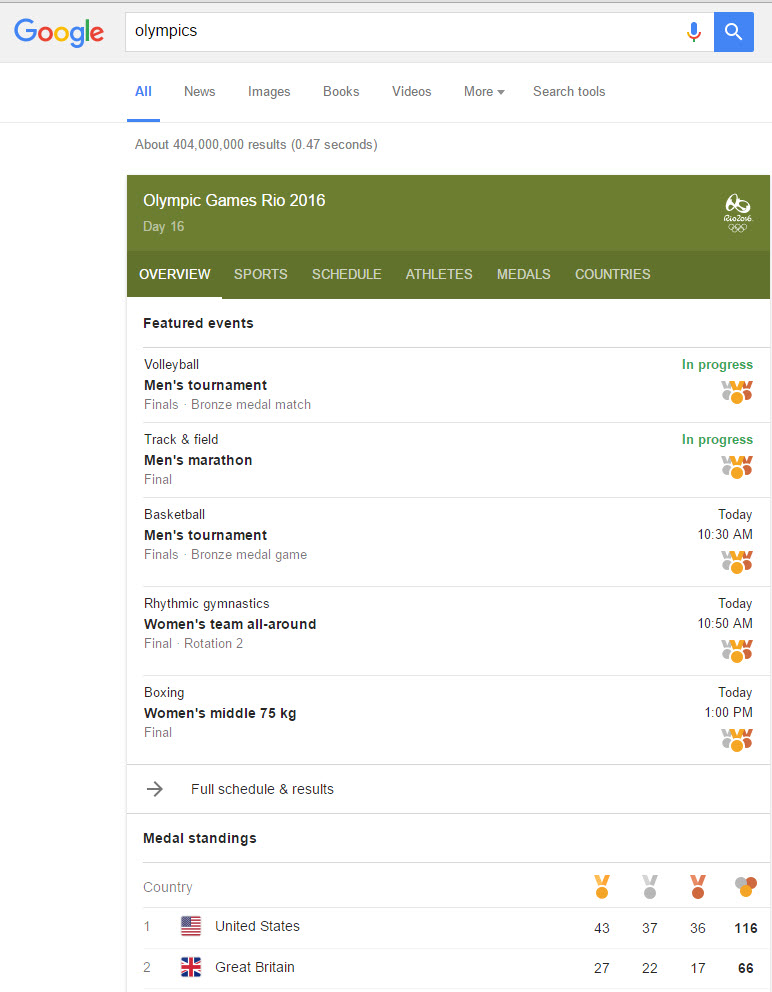
Google’s Olympic feature on desktop utilizes mobile-like functionality
2016 – Quite the Year in SEO
It was obviously a busy year for Google (as well as Bing and others). It’ll be interesting to see how the trends we saw in 2016 play themselves out in 2017. Will mobile continue to be the big story that it was in 2016? Will the narrative in SEO shift, with topics like voice search taking center stage? Will Bing’s ad platform improvement campaign pay off with the search engine becoming a stronger competitor to the ever-dominant Google? I’ll answer all of this and more… in a year from now!




